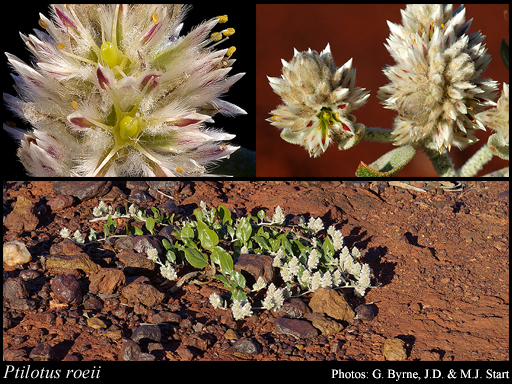- Reference
- Fragm. (Mueller) 8:232-233 (1874)
- Conservation Code
- Not threatened
- Naturalised Status
- Native to Western Australia
- Name Status
- Current
Prostrate to decumbent herb, to 0.7 m wide. Fl. white-other, Feb or Apr to Oct. Stony clay or loam.

Scientific Description
Perennial herbs, stems several, more or less prostrate, persistently hairy or glabrescent, with stellate hairs. Leaves present, 6-50 mm long, 4-35 mm wide, glabrescent, with stellate hairs; basal rosette present; cauline leaves alternate. Spikes white or brown, ovoid or cylindrical, clustered, with densely arranged flowers. Bracts 2.3-3.2 mm long, coloured, hairy, not awned or mucronate, with an obscure or a prominent midrib. Bracteoles 3.2-4.2 mm long, coloured, hairy, awned or mucronate, with a prominent midrib. Outer tepals 4.9-6.5 mm long, entire. Inner tepals 4.7-6.3 mm long, with a basal tuft of hairs on inner face. Style 2-2.3 mm long, straight, centrally fixed to ovary. Distribution: Eremaean Botanical Region; IBRA regions: Gascoyne, Little Sandy Desert, Murchison, Pilbara, Yalgoo.
Distribution
- IBRA Regions
- Gascoyne, Little Sandy Desert, Murchison, Pilbara, Yalgoo.
- IBRA Subregions
- Ashburton, Augustus, Carnegie, Chichester, Eastern Murchison, Fortescue, Hamersley, Tallering, Trainor, Western Murchison.
- Local Government Areas (LGAs)
- Ashburton, Cue, East Pilbara, Leonora, Meekatharra, Murchison, Sandstone, Upper Gascoyne, Wiluna.